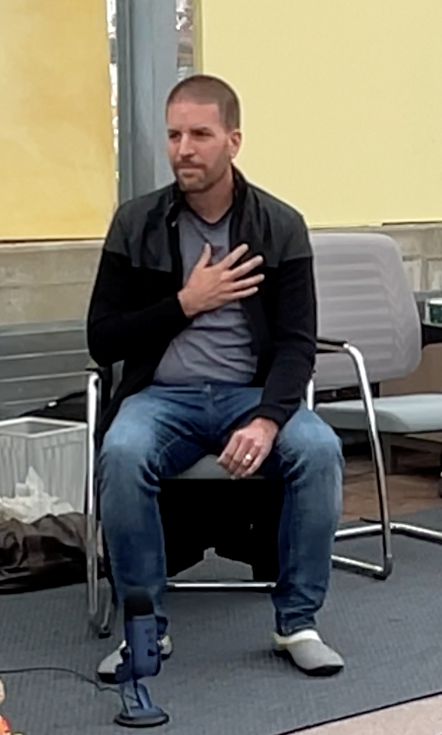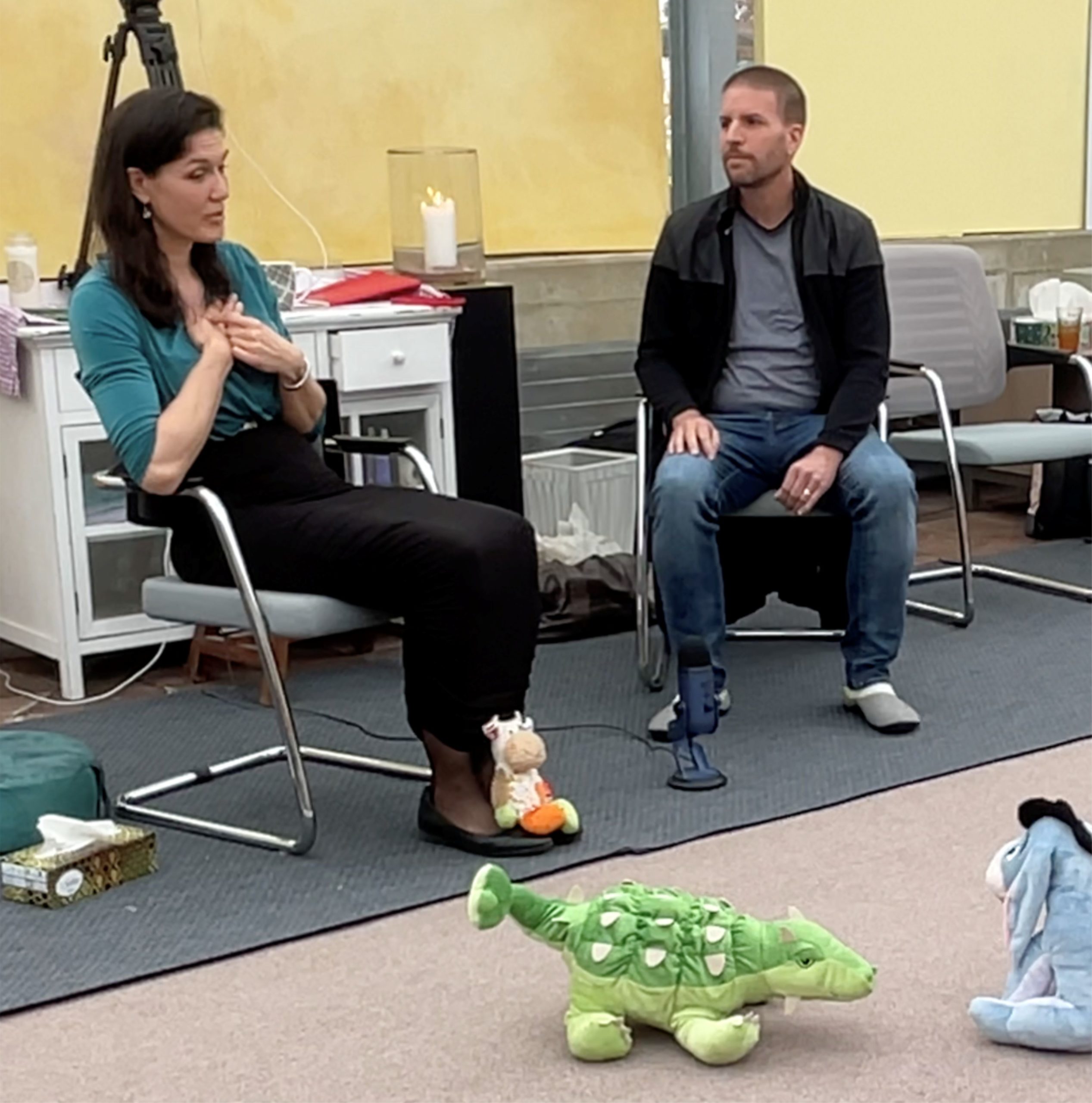IDENTITY ORIENTED
TRAUMA INTEGRATION
A PATH TO RECONCILIATION WITH ONESELF
AND THE WORLD
Have you ever wondered why you feel so dependent or helpless in some relationships or situations? Why you keep repeating the same unhealthy patterns of behavior even though you actually want to change something? If so, then Identity Oriented Trauma Integration might help you answer these questions.
TRAUMATIC EXPERIENCES AND THE CONSEQUENCES
In trauma theory, a key aspect is personality splitting after a trauma. Through a traumatic experience, a part of the personality might split off from the rest and continue to exist inside the person. This inner separation always leads to a projection on the outside. Accordingly, such an inner divide can cause the traumatized person to unconsciously develop unhealthy behavioral patterns on the outside. These then manifest themselves, for example, in states in which a person becomes dependent on the approval, validation and help of another person. The dependent person often loses oneself in a relationship and neglects one's own needs.
In such a situation we can no longer distinguish between inside and outside and thus live in a kind of illusion. At this moment our psyche no longer sees clearly "what is", but through the projection on the outside the split-off traumatized part of the "I".


A JOURNEY BACK TO ME
How can I find my way back to a relationship with myself and the world at eye level, an equal partnership beyond being dependent? Back to a healthy coexistence based on mutual support and an equal distribution of power and responsibility?
The Identity Oriented Trauma Integration by Dagmar Strauss (Schule ICH-Entwicklung) is a wonderful method to work through and integrate traumatic experiences. This method is based on the assumption that traumatic experiences affect all levels of our being - body, emotions, thoughts and spirituality. Through ego-oriented trauma integration, a protected space is created in which the affected person relives the traumatic experiences in order to ultimately integrate them and thereby reduce the effects of the trauma.
The method takes a very resource-oriented approach and places great emphasis on a mindful and holistic approach. All levels of being are included in order to achieve a comprehensive healing. In particular, the affected person's own resources are strengthened and used to support the healing process.
HANDS-ON WORK WITH THE CONCERN PHRASE IN GROUP AND INDIVIDUAL CONSTELLATIONS

By the way, you can find a BLOG article on this topic on our homepage:
Interdependenz, Co-Dependenz und Projektion – Ein Weg zur Versöhnung mit sich selbst und der Welt
Based on the Identity oriented Psychotraumatheory and -therapy according to Dagmar Strauß, I also apply the principle of intent in my practical work in group and individual constellations, combining different body-based trauma integration methods.
The method of Identity Oriented Trauma Integration with encountering oneself through the principle of concern uses constellations with ground anchors or representatives in order to face one's own self and to establish a compassionate and benevolent contact with oneself. This kind of self-encounter can be very profound and enable you to meet your own self directly for the first time, to literally look yourself in the eye.
In the one-on-one sessions and group constellations I offer a protected space in which you can come to terms with your traumatic experiences and embark on the path of healing. I accompany you sensitively and competently on your journey and support you in strengthening your resources and integrating your inner parts.
Along the process, I constantly pay attention to the inner states of all participants and through my empathic consideration I pay attention to your individual abilities, which enable you to approach your inner parts. This is important to avoid overwhelming you during and after the constellation work. A trauma-relieving and integrating self-encounter with traumatized parts from early childhood is only possible if the client is in a well-regulated psychological state.
Please send requests for appointments for individual or group constellations by mail to:
Alexander Martinez
SELF-CENTERED TRAUMA INTEGRATION AND THE HAYDEN MODEL
According to the Hayden Model, the constellation work in groups and in individual sessions touches different body shells (Koshas) simultaneously.

Annamaya Kosha (Foodshell) & Pranamaya Kosha (Energy Body)
The Annamaya Kosha covers everything that we can touch and see. All material living and non-living things thus consist of this shell. It is composed of the five elements of earth, water, fire, air and space. The Pranamaya Kosha represents the bridge between body and mind, because it supplies the physical and mental body with energy. Without prana, there would be no life in us.
Symptoms of trauma on these two body shells can vary and show up in different areas of the body. These include:
- Muscle tension and pain
- Heart racing, increased blood pressure and dizziness
- Gastrointestinal problems such as nausea, diarrhea or constipation
- Sleep disturbances and nightmares
- Changes in the immune system and increased vulnerability to infections
- Hypersensitivity to sound, light, or touch


Manomaya Kosha ( psycho-mental shell)
This layer is described as the emotional shell or mental shell. Manomaya Kosha contains the processing of thoughts and emotions. In it, we place expectations, desires, needs, feelings, fears and memories. Here we experience the moment in yesterday, namely in the categorization of the thing or situation into something known, and in tomorrow, namely in the expectation of a consequence of feeling, thinking or acting. We perceive Manomaya Kosha as an aura and locate it about 1.5 meters around us.
Symptoms of trauma can also show up in this body shell in a variety of ways, depending on the individual experience and the degree of stress. Typical symptoms may include:
- Fear, depression, or other mental illnesses.
- Recurring memories of the traumatic event, which may be caused by certain stimuli or situations (triggers)
- Avoidance behaviors to prevent having to confront the trauma (e.g., avoidance of places, situations, or people that remind one of the trauma)
- Negative alterations in thinking and feeling, such as guilt, shame, fear, anger, dejection, or hopelessness
- Hyperarousal, which is a persistent over-excitement of the body and psyche that may manifest as sleep disturbances, irritability, difficulty concentrating, jumpiness, or aggressive behavior.
INQUIRIES FOR INDIVIDUAL OR GROUP CONSTELLATIONS

Please send requests for appointments for individual or group constellations by mail to:
Alexander Martinez
Setting up the phrase of concern in the individual session
In one-on-one sessions with the client, he or she first describes one's current situation and formulates a personal concern. The client determines the first word of his or her concern and places a ground anchor, such as a cushion or piece of carpet, on the floor for that purpose. The client observes which feelings, thoughts and body sensations arise when the concern is "placed" in the room with the first word. The constellation facilitator comments, mirrors and works out together with the client what happens when he/she gets in touch with his/her concern. Together, each further ground anchor is placed in relation to the previous one and it is examined what changes arise as a result. The client shuttles the focus from one ground anchor to the other, noticing the changing body sensations and emotions allowing him or her to learn a lot about oneself and the issue at hand.
The method of setting up the concern phrase is also very suitable for online individual sessions.
Group Constellation Work
The constellation of the phrase of concern takes place in a group setting, in which the client formulates his or her concern and chooses a representative for the first statement. A dialogue develops between the client and the representative, showing the client what is going on internally psychically at the moment and from where they stand internally in relation to their issue. When the time is right, a new term is added and with the addition of new representatives, the dynamics of the constellation and the reactions of the personality parts change. At the end of a constellation, all representatives are released from their roles.
DAS SAGEN TEILNEHMER
